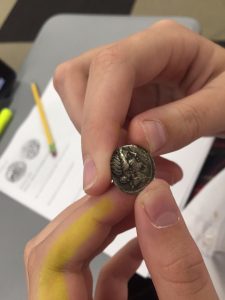I am so grateful for being a teacher in the digital age when resources abound for teachers to incorporate into the classroom in able to make “hands-on” history classes. I am particularly enamored with the resources at the Getty Museum, the British Museum and Google Arts and Culture. Using these resources, I’ve been able to craft some “pre-DBQ” questions for my middle school students to help them to think critically about the messages that historical artifacts, such as coins, might convey and how we can learn to “read” history visually. I especially like the toolkit of Artful Thinking activities provided by Harvard’s Project Zero.
While I was travelling last summer, I picked up some reproduction Roman coins to make the history more real for my students. And so, in my classes last week, students passed around these replicas of coins that correlated to the digital versions accessed through the above mentioned sites. The exercise was all the more real for them because they could explore the coin with all their senses in a way that the digital reproduction could not. However, the digital copies emanating from their iPads allowed them to explore the same “virtual coin” at the same time and to zoom in on details that would have been difficult to see otherwise.
But, one lucky student happened to be holding a real Roman coin, on classroom loan from the family of a former student whose grandfather was an amateur coin collector. I am grateful for their willingness to share this “hands on” opportunity with our school community.

Denarius of Julius Caesar with Venus on obverse, probably minted in Gaul or North Africa, circa 50 BCE.
I believe in the power of digital history to bring the world into modern classrooms. But, nothing will ever substitute for the ability observe the real thing, and in the case of my students, to actually hold the “real deal” in your hand. Touching and, yes, even smelling it, students stare in wonder as they consider all the pockets and places the coin has traveled in its two millennia of existence. I am a lucky teacher to have access to both the analog and the digital versions of this ancient artifact. While the digital will never replace the real thing, it can enhance access to a broader group of people and enhance the ability to look carefully into the past.